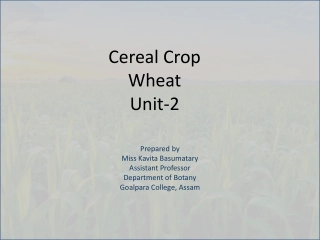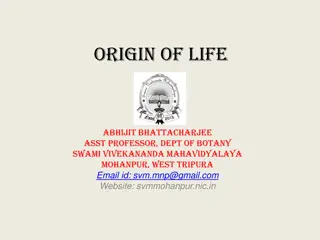Understanding Botanical Names and Common Plant Names
Botanical names consist of a generic name and a specific name, with the first letter of the generic name capitalized and the specific name in lowercase. These names should be underlined or italicized when in prints. Plants also have common and vernacular names that vary by locality, culture, and tribe. Examples such as Dioscorea alata (White yam), Garcinea cola (Bitter cola), Cola nitida (Kola), Aspilia africana (Marigold), and Zea mays (Maize) demonstrate this naming convention. The classification of cowpea highlights its place in the plant kingdom, specifically in the division Spermatophyte, class Angiosperm, order Rosales, and family Leguminosae.
Download Presentation

Please find below an Image/Link to download the presentation.
The content on the website is provided AS IS for your information and personal use only. It may not be sold, licensed, or shared on other websites without obtaining consent from the author. Download presentation by click this link. If you encounter any issues during the download, it is possible that the publisher has removed the file from their server.
E N D
Presentation Transcript
The first of the two names is the generic name, while the second name is the specific name. The first letter of the generic name is written in capital letter, while the specific name is written in small letters all through.
The two names should be underlined separately or italicized when in prints.
Plants are also known by their common and vernacular names which may vary in different localities, cultures and tribes.
Dioscorea alata White yam Isu ewura Doya
Garcinea cola Bitter colar Orogbo Mijigoro
Cola nitida Kola Obi gbanja Goro
Aspilia africana Marigold Yunyun Kausa
Zea mays Maize Agbado Masara
Kingdom - plant kingdom
Division - spermatophyte
Class - Angiosperm
Order - Rosales
Family - Leguminosae
Genus - Vigna
Species - unguiculata
The name of the plant is written as Vigna unguiculata
Plants can be described or classified based on criteria such as size, habit, habitat, life span, behavior etc.
Plants can be described as tree, shrub or herb based on their size.
woody trunk that carry branches well above the ground e.g. Mangifera indica, Khaya senegalensis, Delonix regia, Terminalia catapa etc.
Shrubs are plants or small trees with two or more wordy trunks that developed fron a single rootstock e.g. Hibiscus sp, Ixora sp, Acalypha sp, etc.
Herbs are small plants with soft, fleshy stem e.g. Talinum triangulae, Ageratum conyzoides, Lactuca sativa etc.
Based on life span, plants can be described as annuals, biennials and perennials.
Annuals are plants that complete their life cycle in one season i.e. one year e.g. Oryza sativa, Zea mays,
Biennials are plants that complete their life cycle in two seasons i.e. two years e.g. Allium cepa, Manihot esculenta
Perennials are plants that live for more than two years e.g. Triplochton scleroxylum, Milesia excels, Hildergadia barterii etc.
Plants are also described based on their habitats. Many plants have also developed features that adapt them to their specific habitats.
Mesophytes or land plants are plants growing in regions with average temperatures and moisture e.g. Tithonia diversifolia, Euphorbia heretophylla etc.
Xerophytes are plants growing in the desert or dry places e.g. Cactus sp., Euphorbia sp. Aloe sp., Agara sp.
Hygrophytes are plants growing in moist and shady places e.g. Ferns, some grasses.
Hydrophytes are plants growing in aquatic places e.g. water lettuce (Pistia), water hyacinth
Halophytes are plants growing in saline soil or water e.g. Rhizophora sp., Kandelia sp., Mangrove plants etc.
Plants can be described as erect or scandent based on the nature of their stems.
Erect plants are those with strong stem that can stand on their own without any support.























